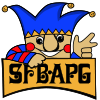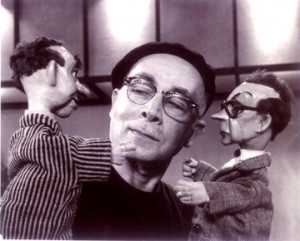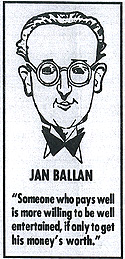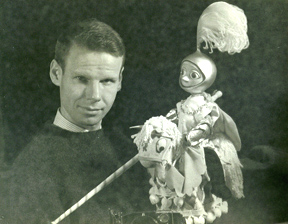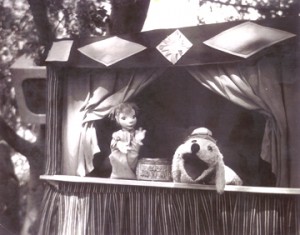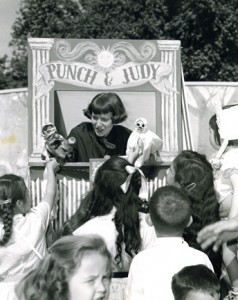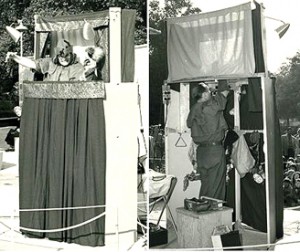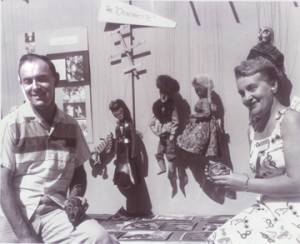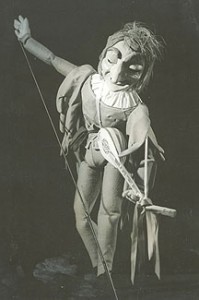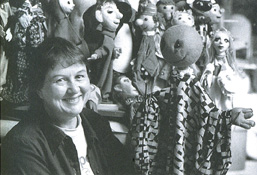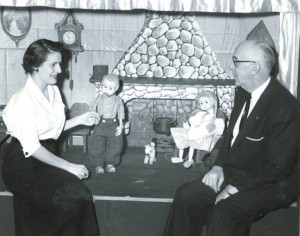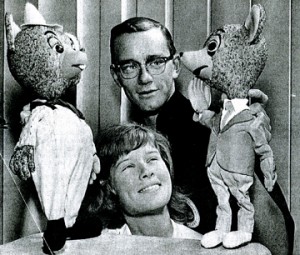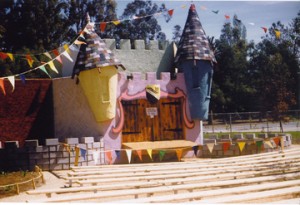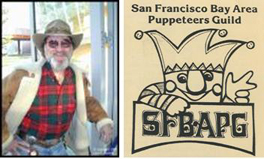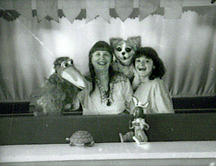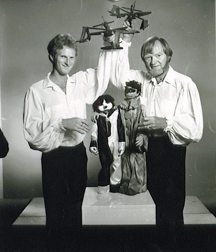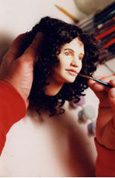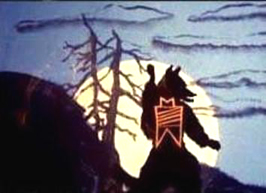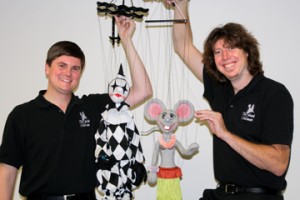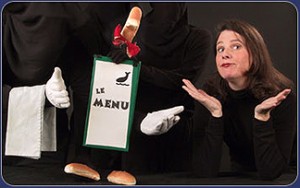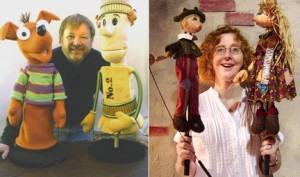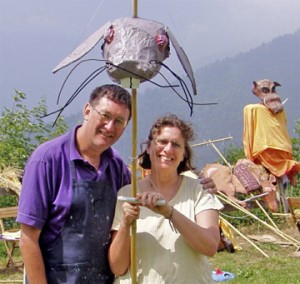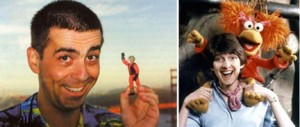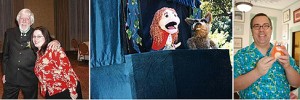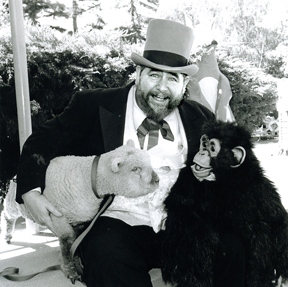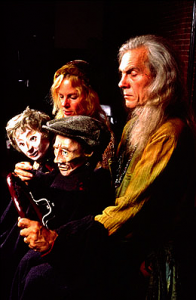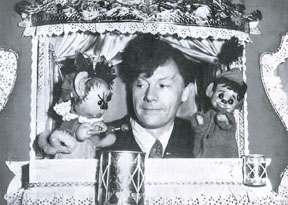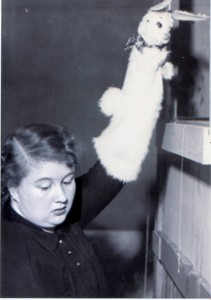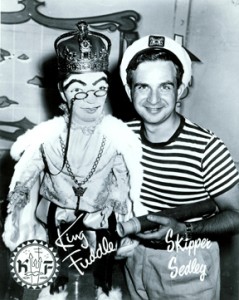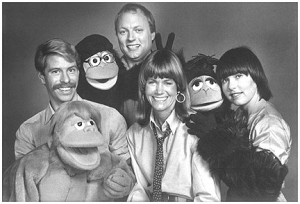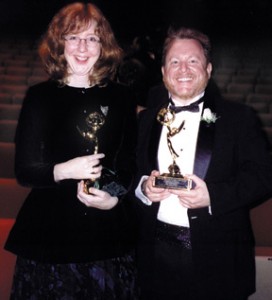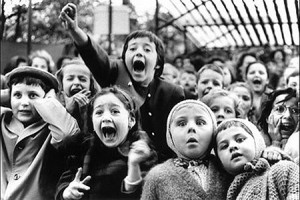By Lettie Connell Schubert (1996) and updated by Randal J. Metz (2010)

“We gathered for fellowship and to share an interest. We have made contributions. We have received inspiration, involvement, training. We have gained from giving. We have gained by receiving. We have made lasting friendships. May we continue to receive, to give, to contribute, and most of all, to elevate the art of puppetry, as friends into and through the next millennium.”
With the above heartfelt words, Lettie Connell Schubert summed up her impressive, yet incomplete, short history of our San Francisco Puppeteers Guild. And now, nineteen years later, I have the privilege of continuing her work and adding on to, yet not completing, our Guild’s heritage. We have attempted to give a wider spectrum of puppetry in the Bay Area this time around, as well as adding photos to the names and achievements listed. And, just a note from Lettie and myself: Our apologies to any Guild members that have also made notable achievements to our art form and have not found their names appropriately listed here. Every lead in researching this history of eighty plus years has led to several more, but often as not we simply did not have the materials in the files for reference. Our sincere apologies. Your efforts are as important as the ones listed. Remember, this is a history of the San Francisco Guild, and members of that same affiliation. The history of puppetry and its effects on California are astounding. This is just one small area of our state. Perhaps the other guilds will add on to this one and present a more substantial document of California’s contributions.
I) The Early Years of Puppetry:
Puppetry is such a diverse art form. Taking into consideration and adapting aspects from other sister arts such as: technical design, carpentry and art appreciation, doll making, live and avantgarde theater, as well as animation and modern day graphics just to name a few. All in the hopes of bringing books and plays to life through the use of inanimate objects.
To understand the background of the Guild’s formation, we first must go back to the 1930’s and note that performing artists Blanding Sloan, Ralph Chesse, R. Bruce Inveriarty, and Enola Barker (who performed with Javanese rod puppets) each produced their own works and shows under the theatrical heading known as the “Marionette Guild”, which lasted for only a few years. The Depression greatly helped to disband this creative troupe of artists and craftsmen. Similar in nature to the San Francisco Guild, this group did much to build audiences for the taste of puppetry. But unlike the SFBAPG, the Marionette Guild was an association of performing troupes, while the Puppetry Guild is more a fraternal association of people with interests in puppets on many levels. Even in spite of the Depression, puppetry flourished as best it could with some companies lasting up to World War II. Pauline Benton of the Chinese shadow theater Red Gate Players, Vivika Place (Heino), John Carter Ford, the Hestwood Brothers, Vera von Pilat, and Otis Cobb (whose beautiful hand carved marionettes served for many performance during the W.P.A. Works Project) were a few popular puppeteers.
But the two men who most are remembered in the Bay Area for the advancement of puppet theater during this time are Ralph Chesse and Perry Dilley. Each preferring a different type of puppet to perform with.
Perry Dilley at work in his studio. Circa 1930’s
Perry Dilley, known for his work with beautiful hand puppets, made his living performing at clubs while teaching and performing at universities. He also ran a small puppet theater out of his home in San Francisco. Mr. Dilley is most known for teaching puppet theater and dramatics at Mills College in Oakland.
Ralph Chesse poses with two of his 1950 television hand puppets.
Although mostly known for his finely carved marionettes reciting Shakespeare, Ralph Chesse was also recognized as a superior artist, actor and performer. On television in the 50’s he created and performed most of the marionettes for the television show “Brother Buzz.” During the W.P.A. (1936-1941), Ralph was the official director of puppetry for the San Francisco, Oakland and Los Angeles districts. Mr. Chesse also painted one of the famous murals that adorn San Francisco’s Coit Tower. Not much is recorded during the war years. Many puppeteers left the area, gave up performing, or took a hiatus. The thread picks up again in the late 1940’s and early 1950’s when puppeteers and puppetry fans only met by chance at mutual performances. Although many fine puppeteers performed in the San Francisco Bay Area, most were traveling troupes and/or celebrities who were passing through our “City by the Bay.” Noteworthy touring performers include the Lessellis (Les & Ellie Heath), the Williams Marionettes from Washington (Robert & Edith Williams), The Kramer Marionettes, Jack & Jackie Shafton, Walter, Lee & Hilton Scott, The Mitchell Marionettes from Whittier, as well as many variety acts that played the Golden Gate Theatre and clubs: Pat Patterson with his pal Pirro, Roger Westley, Walton & O’Rourke, Sabin & her “Personettes,”and Johnny Faust.
Department stores provided venues for puppeteers also. O’Connor & Moffat had shows in the early 40’s. A big well-established shoe store on Market St. hired puppeteer Geri Barish to charm tiny customers. The Emporium hired Chesse & Co. for two seasons – “The Golden Egg of ‘49” was produced for the Market St. store. The White House Dept. Store showcased Lettie Connell in the 50’s in “The Adventures of Benny Bunny” and a three-part hand puppet melodrama “The Man Who Hated Christmas.” Lewis Mahlmann performed at Macy’s. In 1956 Turnabout Theater from Los Angeles opened on Mason St. under the Old Stage Door Theater in San Francisco for a run of several years. In 1956 Hugh Evans and Frank Bray opened Lilliput Theater on Fillmore St. near Union in San Francisco and presented toy theatre (AKA juvenile theatre/model theatre/paper theatre) productions using beautiful enlarged versions of English traditional schoolboy plays.
It was always a rare and wonderful experience in those days when you found someone else with a mutual enthusiasm for puppetry. Our friends and relatives did not always appreciate this curious passion, and so we needed others who shared this great interest we had. This was the beginning of the foundation for the creation of our Guild.
II) The Fabulous Fifties:
Although the actual Guild would not become official until 1961, the decade of the 50’s planted the artistic seeds from which our Guild’s “Puppet-Tree” would grow. The following local puppeteers met and discussed ideas in houses, libraries and any convenient meeting place they could find. A loving and giving group of talents, they often banded together helping each other produce theatrical presentations. Besides some of the already mentioned notables, local performers included:
Jan Ballan “The Chattering Magician” who performed his hysterical “Punch’s Adventures in Turkey”, whenever he could find a captive audience.
Benjamin Blake & knight friend from his Studio 9 Marionette Theater. 1963
Benjamin Blake, was a local art instructor who created beautiful carved puppets which came alive through the unique planes and angles that formed their faces. Mr. Blake’s puppets also performed on television with noted actor Ray Bolger (Scarecrow in Wizard of Oz) in a holiday special called “The Little Sweep.”
Lettie Connell Schubert amazed audiences with her careful hand puppet manipulation in performance and on television. Her puppets also performed in department store windows during the holiday seasons. Twinkle & George, her puppet personalities were well known in the windows of “Happy Things,” a toy store she and her husband ran.
Lettie’s Twinkle & George the dog perform for kids. Circa 1960’s
Marian Derby performs her delightful Punch & Judy for the kids. Circa late 50’s
Marian Derby, known for her wit and clever puppets, often combined social issues and satire in her puppet plays. Marian also developed the hand puppet patterns widely used today with the help of Lettie Schubert and Lewis Mahlmann. (Notice pattern used for Lettie’s puppet Twinkle)
Ray & Betty Mount, a husband and wife team who specialized in hand puppets and vocal characterizations.
Ray and Betty Mount perform at Fairyland in 1952.
The Oznowicz Marionettes were a popular treat performing yearly at Yosemite National Park and other venues. This European family included Frances & Mike Oznowicz and their young son Frankie! Soon to be known internationally as Frank Oz of the Muppets. Mike and Frances were pillars of puppetry nationally and internationally. Frances also produced many tutorials on costuming puppets. Being a dress maker, she simplified in her books,the steps used for making magnificent puppet costumes.
Mike & Frances Oznowicz display their puppet family. 1957
Lewis Mahlmann performed puppet, classical theater, out of his Haight St. home under the company name of “The Lilliputian Players.” These were adult, theatrical pieces many times accompanied by live orchestration. “Blue Beard,” “Sigfried,” “L Enfant et los Sortileges” and “Midsummer Night’s Dream” were just a few classics given his touch. Later, Lewis would become the director of the Fairyland Puppet Theater.
Minstrel from Lewis Mahlmann’s Lilliputian Puppets – Blue Beard Circa 1960’s
Other notable performer’s from this time period include Ralph Geddis & Francois Martin from Carmel, Grace Wilder, Wolo Von Trutzler, Bert Hansen who performed Punch and Judy. There were also amateur/hobbyist groups such as the High Strung Theater: Charlotte & Bob Black, The Dreschers, Lorraine & John Kraft, Barbara and Jack Mee, and Clyde Forsman (who all shared an enthusiasm for folk dancing as well as marionettes) who produced memorable productions such as “Shakes vs. Shaw” and “Archie & Mehitabel” in a finely crafted little theater in the Blacks’ home.
The 50’s also gave us three permanent public puppet venues to watch shows at anytime we wished. Two were in amusement parks, and one was a product of an ambitious Parks & Recreation Department. And so, before we actually bring the San Francisco Guild to life, I must speak a little on these three puppet venues!
III) Three Popular Puppet Places (1948 – 2010 & on):
With the popularity of puppetry running rampant in our evolving culture, recreation programs were quick to pick up on this creative trend. Traveling Rec. puppet shows opened up in communities all across America. One such program was The Vagabond Puppets in Oakland, CA — 1948 to present.
The Vagabond Puppets
The Vagabond Puppet Trailer with awaiting audience. Circa 1954
The W.P.A. Works project ended in 1941 what it began in 1936. Federal puppet theaters closed, but what do you do with all the puppets that the government paid puppeteers to build? Ralph Chesse, then Federal Regional Puppet Director of Los Angeles, San Francisco and Oakland, managed to crate and remove many of them to the Oakland Parks Department where they would remain unused for many years.
Finally, in 1948 Joyce E. Lobner, a puppet recreation director, would revive one of the shows under the troupe heading of The Stardust Puppeteers. Joyce would continue to use the W.P.A. puppets to tour the recreation centers and parks of Oakland until 1953. This was the beginning of the Vagabond Puppet program.
In 1954, Lettie Connell Schubert took over the existing program and inaugurated the Vagabond Puppet Theater. The trailer theater, which resembled a circus wagon, brought puppetry to thousands of children in addition to providing a fine training ground with many jobs for local puppeteers. The W.P.A. puppets were retired and new ones created for the smaller performance proscenium of the traveling trailer.
Lettie C. Schubert and some of her many puppets. 1984
During Lettie’s six year directorship of this exciting program she had the opportunity to train and work with many young puppeteers and artists. Amongst them were: Paul Miller, Robert Edward Darling (now famous set designer and director of operas), Dahl Delu, Darryl Ferriera and Sally Hanson.
“Beauty & The Beast,” Vagabond Trailer 1958. puppets by Lettie Schubert, sets by Robert Edward Darling.
Sally Hanson prepares for a Recreation puppet class. Circa 1960’s
In 1957 junior puppeteers Jerry Juhl and Frank Oznowicz would join Lettie’s program and then become directors themselves in 1961. That year, Jim Henson would see their show at a puppet regional festival and hire them on the spot to form his new: Muppets! Jerry left at the end of the year, while Frank had to stay behind to finish high school and remain director of the Vagabond Puppets for one more year. The rest is another history.
Jerry Juhl, head writer for the Muppet Show. Early 2000
Puppets by young Frank Oznowicz for Vagabond. 1961 – 62
From 1963 to 1969, the Vagabonds were under the direction of Ruth Sinclair, who once more turned to the W.P.A. puppets as a source for traveling shows. The trailer was retired and the puppets took up residence in Mosswood park.
In 1970, Bruce Chesse, son of Ralph Chesse, took over directorship of the program. Bruce favored an interactive, “involve the kids,” “muppety” form of show. And so he used a sparse stage set up, and vaudeville theatrics to enthrall the audience. After three years, he would retire and pursue other venues, such as shadow puppets and becoming a resource specialist in educational puppetry. During his tenure, Fred Jackson (a mime and puppeteer) would work beside him. Fred Jackson would also run a companion puppet program in the rec center for many years known as “Junk’n’puppets.” A program using recycled materials to make simple puppets and put on a show. The Vagabond Puppets once again traveled the city.
Ralph Chesse and son Bruce at Puppet Fair 1978
In 1973 the program would fall into the capable hands of puppeteers Richard & Julie Greene of The Puppet House. The Greenes favored hand puppet shows with lots of gimmicks and surprises. They often dressed appropriately to the theme of the presented show, and took their stories from multicultural fables. They would run the program for the next three years.
1974 Fairyland Puppet Fair featuring the Vagabond Puppets. (l – r) Julie Greene, John Gilkerson, Sharon Collier, Lewis Mahlmann, Kathy and Randal Metz, Paul Kennemore & Richard Greene.
1976 found puppeteer Earl Rhue guiding the talents of Vagabond. Mr. Rhue joined the Greenes in 1975, and worked with Fred Jackson of the Junk’n’puppets program. An educator and talented actor, Earl favored large puppets similar to the type used by Bruce Chesse. Earl will run the program until 1980.
Joining the Vagabond puppets in 1976, the talented Blake Maxam took over in 1981 as director. Blake, known as “The Wizard of Ahhhs” is a professional magician, director and equity actor. He will help run the program for the longest time period, a total of 32 years during his tenure at the Oakland Rec. Dept. There will only be three years he wasn’t involved due to other recreation commitments.
In 1985, Randal Metz of The Puppet Company will direct the program presenting “The Adventures of Pinocchio.” This will be the first time the program does not own the puppets and presentation. Randal was Director of the Oakland Knowland Park Zoo puppet theater from 1978 to 1980, and currently Artistic Director for Children’s Fairyland in Oakland. He will be loaned to the Recreation Dept. for the year.
In 1986, Daniel Taurines of Geppetto’s Puppets will present his own “Beauty and the Beast,” as a fill-in show until Blake returns. Daniel went on to take his show on tour in Europe and other countries.
In 1987, Fred Jackson will return for one year to run the program with the help of Earl Rhue. They will present a cautionary puppet show teaching kids to avoid drugs and bad habits.
Blake will return in 1988, and the program continues to perform in Rec Centers and libraries throughout Oakland.
Blake Maxam and his Marx Bros. Three Pigs tale called “A Day In The Forest” — Vagabond Puppets. Circa 2000
The Children’s Fairyland Storybook Puppet Theater:
In 1956, the city of Oakland will open what is to become “the longest, continuously operating, puppet theater in the United States.” From 1956 to today, the theater will showcase the talents of many puppeteers, from the Guild and otherwise, and entertain youngsters on the grounds of Children’s Fairyland U.S.A. Children’s Fairyland is the first children’s park of its kind, opened in 1950 on the shores of Lake Merritt. Working closely with the SFBAPG, the theater will flourish over the years under the capable hands of five puppet theater directors.
The Storybook Puppet Theater of Children’s Fairyland. Shown as it was in 1956 and then again 50 years later in 2006.
This landmark theater was designed by artist William Russell Everritt with the help of Guild advisors Ralph Chesse, Lettie C. Schubert, and Wolo Von Trutzler. Paid for by the citizens of Oakland and The Lake Merritt Breakfast Club. Children’s Fairyland, which was a project of the Parks Department (later the Parks and Recreation Departments merged), contributed equally to the local puppetry scene and the Guild when it opened.
The Hayward Marionettes, Frank & Dorothy were the first directors of the theater. Frank Hayward, also a professional magician, will unfortunately pass away after the first year leaving his pregnant wife Dorothy with the directorship of the theater. Dorothy turned to help from the fledgling San Francisco Guild who supported her by lending their shows to fill out the ranks of already created Hayward productions. Guild members who loaned their early shows were Marian Derby, Lewis Mahlmann and Roberta Mack.
Frank & Dorothy Hayward with Hansel and Gretel 1955
While still acting as Director, Dorothy turned her eyes to looking for a puppeteer to be on grounds helping her with future productions. Puppeteers Beverly Philis and Clifford Coite will work with her. But newcomer Bob Mills will make the biggest difference. A well known puppeteer from Hawaii, and new to the Guild, Bob worked for one year at the park helping to build new shows and then was stolen away by Walt Disney to direct his brand new puppet theater on Disneyland grounds at the Tinkerbell Toy Shoppe. After four and half years at Disneyland, Bob would change careers and become a professional Makeup Man for television and film.
Bob Mills directs the Disneyland Puppet Theater. 1958.
And so, once again Dorothy went looking for an assistant. Enter Tony Urbano. Tony just released from the army was looking for a job in puppetry. While Dorothy ran programs for Fairyland, Tony maintained the puppet theater. In 1959 Tony became the 2nd director of the theater and continued as such until 1962. Tony is well known for his beautiful marionettes and work in films such as “Men In Black,” “Flight of the Navigator” and the “Short Circuit” films. Tony has toured the world and makes his living in the Los Angeles area. In fact, Tony was living in L.A. and building shows for Fairyland which he delivered bi-monthly during the last years of his time at the park. He retired from the park due to the commute and a thriving Hollywood business. Nancy Mott, Sally Hanson, Darryl Ferrieria, Don Ingraham and Frank Oznowicz (Oz) all worked with Tony at the park
Tony Urbano and Prince Charming at Fairyland circa 1959
And so in 1963 the park looked for a third director. Luman Coad became that person. Luman was studying Children’s Theater and currently working in Happy Hollow Park & Zoo in San Jose. He quickly left the zoo and became the youngest director of our theater. Fine manipulation and gentle, problem solving tales, are trademarks of Luman’s work. He married his assistant Mary Rait and ran the theater for the next three years. Luman and Mary separated and then he moved to Canada where he formed (with Arylnn Coad) the famous Coad Canada Puppets. (He also met Arlynn for the 1st time at Fairyland) His puppets have traveled the world and won numerous awards. He currently publishes books on puppets under his own publishing company Charlemagne Press. He is still an international member of our Guild.
Luman Coad & Mary Rait with Town Mouse & Country Mouse. 1963
Our fourth theater director came from San Francisco. A charter member of our Guild, and past president of the Puppeteers of America, Lewis Mahlmann moved across the bay and settled in Oakland. For the next twenty four years he will be at the helm of the Storybook Theater. A singer, actor, dancer and musician, Lewis brought all these talents to the theater. His tales came from fables, opera, ballet and other cultures. He also never hesitated to ask other puppeteers to build for him and the theater. He and his partner, David C. Jones, published four books of puppet plays which are much sought after today. Each play having performed at Fairyland. He will also mentor the talents of John Gilkerson, Randal Metz, Tom Royer, Evy Berman-Wright, Kevin Menegus, Jesse Vail and many others.
Lewis Mahlmann with his puppets from “Believe in Me.” Circa 1996
Puppet Playwright David C. Jones and cast of “Little Indian Brave.” 1987
In 1990, Lewis will form the partnership of M Plus M Productions (Mahlmann & Metz) and team up with his apprentice of twenty years, Randal Metz. The two of them will co-direct the theater until 2004 when Lewis will Semi-retire and Randal will continue as Puppet Director.
Randal Metz grew up in Fairyland. At age 10 he began working with Lewis. He runs his own business (off of park grounds) known as: The Puppet Company. Randal has also apprenticed with Lettie Schubert, Bob Baker of Los Angeles and the Muppets. For twenty years he was Artistic Director of Children’s Fairyland. Working alongside Metz at Fairyland you can find Rhonda Kaye, Jesse Vail, Annie Wong & Michael Flores.
M Plus M Productions: Lewis Mahlmann & Randal Metz. Fairyland 1993
In the late 1950s there was a tremendous exchange with the two Oakland Rec staffs and Guild members doing voices, helping build puppets, sets and costumes, sharing ideas and techniques, writing plays for each other! Other Bay Area Recreation departments sponsored classes and programs sporadically, but only Oakland has supported puppetry on a regular basis for such a long time. The Storybook Theater is celebrating its 54th successful year of continuous operation. Here’s to many more!
The Puppet Castle at Happy Hollow Zoo:
The Puppet Castle at Happy Hollow Park & Zoo Circa 1998
The third puppet venue in the Bay area is also found at an amusement park. The Puppet Castle opened at Happy Hollow Park & Zoo in 1961, based on the success of Childrens Fairyland’s Storybook Puppet Theater. Over the years, many of their directors and assistants have been members of the SFBAPG.
Only three of their main puppeteers have been successful, professional puppeteers. The theater has mostly been run by staff recreation leaders who have used previously designed puppets and their own figures to create new shows and tales. Unlike Fairyland, the director is employed by the City of San Jose and not an independent contractor. Therefore, all puppets and properties created belong to the city and Happy Hollow. Professional puppeteers who have worked at the theater include Luman Coad (see Fairyland), Jesse Vail and Judy Roberto.
Luman Coad began his puppet training at Happy Hollow and left to direct the Fairyland Puppet Theater. The castle theater was just opening at that time, and Luman used his own shows to supply performances while staff built future productions.
Luman Coad with puppet friends. 1962
Ron Skolman and Virginia Hull directed the theater for the first years. Other San Jose directors have included Michael Rudd, and the longest running director Christine Castello.
In 1998 Jesse Vail of Fool Moon Puppetry Arts took over the running of the theater. A professionally trained puppeteer, he revamped the Castle Theater, created new productions (they had been using the same shows for years), and upgraded their Summer Camp with new puppet workshops for kids. In 2004 he left to pursue his own puppet company and create props for local theater productions.
Jesse Vail with puppets from Old King Cole. Circa 2001
After forty six successful years of puppets, in 2008 Happy Hollow closed their gates and have since redesigned the entire park. The Puppet Castle is one of the few original set pieces spared from destruction. The Castle has opened again for performances in 2010, and is currently under the direction of Judy Roberto.
Happy Hollow puppet director Judy Roberto and cast of “3 Pigs” 2010
This then is the rich mixture that local puppet fans enjoyed in the early days and through our 50th year.
IV) The Turbulent 60’s:
And so we began our journey in the early 50’s. Although not officially a chartered Guild by the Puppeteers of America, we considered ourselves one, none the less. The SFBAPG was founded by seven original Guild members meeting in 1954 at the Oakland Public Library. Anyone interested in puppetry was invited to attend meetings by librarian Inga Strehlow.
And then on February 11, 1961, our local community of puppet enthusiasts was recognized as The San Francisco Bay Area Puppeteers Guild by The Puppeteers of America. Patrici Lavin became our 1st provisional president. William Stewart Jones, Lewis Mahlmann, and Tony Urbano who were all members of the board for Puppeteers of America paved the way for us to become recognized Guild Charter #7. Although the Guild had been meeting regularly since 1954, its members had not felt the necessity of applying for a charter until some of the members accepted the responsibility of hosting the 1961 National Festival at Asilomar on the Monterey Peninsula. In order to hold a festival, you had to be recognized by the mother organization of Puppeteers of America. This allowed you to find extra support and funding. After much discussion, a majority of the Guild finally voted to apply for the charter. Lettie C. Schubert and Dorothy Hayward were to be co-chairs of the festival. However, Dorothy met and married Gil Oden (curator of Theater Arts at the Detroit Institute of Art) and left Lettie as Festival Director for our first major festival.
Charter members of the Guild included: Jan Ballan, Mr. & Mrs. Leonard Colton, John H. Crafts, Lettie Connell (Schubert), Marian Derby, Dahl Delu, Ray Fenton, Clyde Forsman, Sally G. Hanson, Sydney Kittinger, Hanna W. Lavin, Mary Patricia Lavin, Roberta G. Mack, Lewis Mahlmann (then Vice President of Puppeteers of America), Barbara Mee, Frances Oznowicz, Frank Oznowicz, Mike Oznowicz, Patricia Whitehill, Talma-Zetta Wilbur, and Wolo Von Trutzler. Some early members were: Charlotte & Bob Black, Luman Coad, Darryl Ferreira, The Gadburys, Dorothy Hayward, William Stewart Jones, Tony Urbano.
Acting for the Puppeteers of America were: John U. Zweers, President; Lewis Mahlmann, Vice President; Margaret Bennington, Secretary; and board members signing were Donald Coleman, Margaret Fickling, William Stewart Jones, Joseph Owens and Jean Starr Wiksell.
But what about a logo!? The original logo was designed by William Stewart Jones. Bill Jones was not only a fine puppeteer, working with many puppet companies in the 60’s, he was also a theatrical costumer and prop and makeup designer. He taught all of these for many years at San Francisco State University. His most famous achievements are recognition for the design of the crazy large hats worn in San Francisco’s “Beach Blanket Babylon” as well as head makeup artist for the San Francisco Opera.
William Stewart Jones, circa early 2000’s and his Guild logo.
Bill also designed the original hand logo for UNIMA-USA at the request of Mollie Falkenstein, who was Secretary General at the time. Bill designed, and made, the original Guild banner which, sadly, was stolen while it hung outside during a weekend meeting at Santa Cruz. His little character was redrawn in the 1970’s by Bev Armstrong, and was even interpreted by Elva Aiken as a pair of three-dimensional figures carried in the parade at a National Festival at San Luis Obispo. Bev’s reworking of the design is to be seen on the Guild’s informational flier, where our trademark is found represented by many forms of the puppet.
Beverly Armstrong drawings of Guild logo. Circa late 70’s
Guild members had been organizing puppet fairs at Children’s Fairyland and other special events since 1956. However, to test its capabilities and learn the responsibilities of festival-giving, the Guild sponsored a trial Regional Festival in 1960. Ably assisted by Lewis Mahlmann, Marian Derby, Bill Jones, Pat Lavin, Roberta Mack and the Oznowiczs, Lettie Schubert chaired the first California Regional. A banquet was held at the Opus One, an infamous restaurant in the heart of the Beat scene. Performances were given at the Little Fox Theater on Broadway in the old International Settlement in North Beach. Workshop leaders were Ralph Chesse, Virginia Opsvig Kerr, Dr. Clarence Miller from San Francisco State, Shirley Eoff, Dion Chesse, Robert Edward Darling, Lewis Mahlmann and Lettie Schubert. Participants from out of town stayed at hotels. This first festival realized a profit of $25.00 which became the basis of the Regional Treasury. And as such we began our Guild journeys.
V) The Wild 70’s:
One can only call the decade of the 1970’s as being the time of “Muppet Mania!” Jim Henson was influencing the children of the United States with his Sesame Street characters, and everyone wanted to be like the Muppets. Frank Oz (nowicz) even returned to Fairyland for its 20th birthday party with Bert and Cookie Monster in tow. Hosted by Guild member Darryl Ferreria, what was expected to be a small turnout became a crowd of thousands. Puppetry was here to stay in the minds of the baby boomers.
Bert, Lewis Mahlmann and Frank Oz (returning to Fairyland) 1970
In 1974, the Guild started the infamous Guild library. Librarian Richard Greene was in charge of a whopping 10 books. Today the Guild library numbers some 300 or more books and video tapes. Also of interest was the attempt to form a sister Guild in the Palo Alto area. Under the guidance of Guild member Betty Polus/Elisheva Hart, The Punchinello Guild met off and on from 1976 until the middle 80’s when they finally disbanded. This was never a chartered Puppeteers of America Guild, just a group of puppet friends. Betty Polus (aka Elisheva Hart) and her puppet company The Dragonfly Puppets have performed in the Bay Area since the early 70’s. Betty was also the shadow consultant for the P of A organization. She specializes in intimate theater using different types of unusual puppets to convey her tales.
Betty Polus /Hart (L) and Lee Armstrong (R) surrounded by their puppet friends in photo for late 80’s Puppet Fair
In the 70’s, the Guild realized early that it needed an influx of young members. More than at any other time period in its history was that answered. With the popularity of the Muppets, teenagers came out of the woodwork to answer the call. Junior members included Tom Royer, Paul Kennemore, Vernon Philips, Mike Davis (later Michael Earl of the Muppets), Elizabeth Luce, Randal Metz and John Gilkerson. The Guild was, and is, a unique place for fostering and encouraging young puppeteers. Most received training at Children’s Fairyland. Three went on to start thriving Bay Area puppet companies:
John Gilkerson formed the Gilkerson Puppets with the help of his Mother Naomi (another puppet Guild member). John was a dancer, actor and scenic/costume designer. He made costumes for the Oakland and Vienna Ballets as well as worked on a puppet show with Frank Zappa (A Zappa Affair). He also designed display windows for Gumps. Taken from us too young, his last accomplishment was working on T.V.’s “Buster and Me” as Russell the Orangutan. John was also an artistic director for Children’s Fairyland.
Junior Guild members Randal Metz w/Peter Pan, Tom Royer w/Uncle Remus and John Gilkerson with the Queen. Newspaper clipping for 1977 Puppet Fair.
Randal Metz and Tom Royer formed The Puppet Company and became the puppeteers for the Oakland Zoo. In 1981 Tom left to work at Disneyland as an employee, and Randal took the company and remained in the Bay Area working for Children’s Fairyland, performing, and traveling with theater troupes and small circuses. He is now director of the Storybook Puppet Theater in Fairyland.
Another interesting little “puppet fact” about the growth of the Guild concerns children’s librarians. In the 60’s and early 70’s, part of a librarian’s degree featured a class in producing puppet shows and using puppets for storytelling purposes. Many librarians joined the local Guilds, and P of A, as a means of furthering this degree. By late 1978 this was not a requirement any longer, and so the Guild now has fewer librarians than in the early years. This change will pave the way for professional puppet companies to start performing in the libraries where as before the librarian created her own puppets and usually had a small stage for the children to play with.
VI) The Experimental 80’s:
The next decade for the Guild passed pretty peacefully. As always, we were looking for new talent to join our group and swell the ranks. It seems like everyone was busy trying to make a name for themselves in the field of puppetry. And puppets were being discovered as a new means to be “theatrical.” Found Object Theater – Shadow Manipulation – Stop Motion Animation – Puppets & Storytelling (particularly pocket apron tales), avantgarde theater & masks, and of course the Muppets and film, were all avenues to be explored and discovered by our artistic puppet community. As people came and went, two Guild members almost single handily kept us together as a cohesive group. Lettie Schubert and storyteller/puppeteer Kitty Adams took turns being president over the decade and spent many hours cutting and pasting our newsletter to keep us informed. Member Betty Polus/Elisheva Hart also aided by finding interesting, different, puppet news to report on. It seemed like each new member to the Guild brought a different set of skills that we all could learn from. Some newcomers included:
Joe Leon entertains with his Caterpillar Puppets
The Caterpillar Puppets, Joe and Ronna Leon arrived in the bay area near the end of the 70’s. With degrees in theater and art, they featured colorful, intimate tellings of classic tales. They have performed in Moscow and Canada, and have been the puppeteers for Marine World Africa U.S.A.
Father and Son marionette team, Jack & Chris Fredricks, formed Walden’s Marionettes. Jack was a former school teacher and artist, and his son Chris studied with marionette expert Albrecht Roser of Germany. The Walden’s featured marionette revue stories, and taught many classes and educational puppet programs in schools all over California. Jack and his marionette friend also were featured in an early episode of the popular “Fraggle Rock” TV show.
Father & Son Team Chris and Jack Fredricks – The Walden’s Marionettes
PuppetWorks was the brain child of Jamie Keithline and Bonny Hall. The young couple began their very creative career here in the Bay Area, after meeting while getting their Bachelors & Masters degrees in puppetry at the University of Connecticut. In 1989 they returned to the East Coast and changed their name to Crabgrass Puppet Theatre. The couple have won many prestigious awards for their theatrical works.
Puppetworks…now Crabgrass Puppet Theater – Jamie Keithline & Bonny Hall
Steve Overton is the creative genius behind the Olde World Marionette Theater. His own brand of puppetry is called “Mari-ku.” Joining the forms of marionettes and Japanese Bunraku theater, Steve and his crew work the marionettes visibly in front of a black curtain. After running a successful theater in Pacifica for many years, he has now moved to Oregon where he can be found.
Steve Overton and his Renaissance marionette. Olde World Marionette Theater
In 1987, Lee Armstrong and partner Rhys Wade formed “Images in Motion.” In 1988 the company was reformed with Lee Armstrong and Kamela Portuges as co-owners. Winning Emmys and visualizing dreams are just two of the things they do best. Lee and Kamela run a full video service for young filmmakers, create custom puppets for commercials and film, and sculpt countless products for the toy industry. Mike Wick, animator and master puppet builder, works with this tireless duo helping to create quality products.
Images in Motion Kamila Portuges works on head of Cameron Diaz for “Being John Malkovich”
The Bay Area is also home to one of the finest shadow puppet companies there are. Larry Reed founded ShadowLight Productions in 1972 as a way to nurture indigenous shadow theater traditions and to explore and expand the possibilities of the shadow theater medium by creating innovative interdisciplinary, multicultural works. Mr. Reed is also an accomplished theatre artist and filmmaker besides a shadow expert.
A scene from “Coyote’s Journey,” Larry Reed, ShadowLight Productions, 2000
By the late 80’s, Michael and Valerie Nelson had arrived in the Napa Valley with their Magical Moonshine Puppet Theater. The Nelson’s shows use live music, large bunraku puppet figures and clever scenery that blend together into a fun, lively or educational “treat for the eye.” They’ve won numerous national and international awards, and Michael studied puppetry at the International Puppetry Institute in France with Jim Henson.
Magical Moonshine puppeteers Michael and Valerie Nelson with son Benji, meet Kermit the Frog and Jim Henson. 1987
These are just a few of the vibrant companies that found a home in the Bay Area. Also working at this time are Daniel Taurines of Geppetto’s Puppets, Terry Ryder and her Punch and Judy exploits, the Indonesian shadows and puppets of Kathy Dodge, Howie Liefer and his often political “Haight St. Puppet Theater used many forms of puppets to get his point across, while Denys Adida entertained with her powerful use of masks and puppets. And for a great laugh, Bob Hartman of Hartman Puppets could be found nightly performing at The Cannery on San Francisco’s Fisherman Wharf.
VII) The Confident 90’s:
In 1991, the SFBAPG turned thirty years old. We were now entering our middle ages. The Guild celebrated by holding a huge party event, sending invitations to past members, puppet enthusiasts in other Guilds, and “big wigs” throughout the puppet world. The event was so huge, thirty nine Guild members went above and beyond the call and donated their private funds to cover the costs. In the end, one hundred and twenty (rather than the average thirty per meeting) party guests attended the evening event. Featuring talents from across the puppet spectrum, President Michael Nelson had something there for everybody.
And so we ventured into the decade with confidence in ourselves, the economic situation, and that puppets were one of the number one attractions for the entertainment industry.
As a result, an influx of puppet companies joined the Guild and once again the SFBAPG found itself the mentors of a large junior puppeteer community. Young members included Sean Grady, Martin Leon of Caterpillar Puppets, Sean & Patric Johnson, and Kevin Menegus.
Junior members perform at Puppet Fair: Twins Sean and Patrick Johnson and Martin Leon (l) and Sean Grady (r)
The dynamic duo of Sean and Patrick Johnson embraced the puppet Guild and its teachings. Fans of Jim Henson, their puppets reflected his style. They are also talented mural artists, video directors and actors. Starting out as The Johnson Bros. Puppets, they then moved to L.A. and became L.A. Puppet Pros. And finally created the offices of Swazzle. Today the Johnsons run a busy workshop in Los Angeles catering to puppet films and productions.
Kevin Menegus is an accomplished musician and marionette maker. At a young age he knew he wanted to work with marionettes. He has studied with Tony Urbano, Bob Baker and the Fairyland Puppet Theater. Kevin and longtime friend Michael Burroughs formed The Fratello Marionettes in 1989. Today Kevin works with talented puppet manipulator Fred C. Riley III. When not manipulating, Kevin is a percussionist for musical theater.
The Fratello Marionettes: Kevin Menegus & Fred Riley. 2009
Liebe Wetzel, though not a junior member, took the theatrical world by storm with her “ordinary object puppetry” and the antics of her company Lunatique Fantastique. Liebe started as clown Too Too Tomato, and filled out her puppet skills with mime, stilt walking and commedia dell’arte antics. She teaches extensive workshops on object and puppet movement.
Liebe Wetzel of Lunatique Fantastique and “Cirque du Celery.” 2002
Roger Mara, and designer Elizabeth Luce, moved from the Los Angeles area and started up Snapdragon Puppets. Roger’s shows were filled with memorable puppet characters and often the puppets were manipulated by ingenious gears and mechanisms. He is well known for walking on stage with a suitcase, opening it, and an entire puppet stage fell out and set itself up. Elizabeth Luce (a former junior puppeteer) has a MFA from UCLA in set and costume design. A designer of puppets, she worked most closely with Roger. She has also won numerous awards for puppet design and directing.
The Snapdragon Puppets – Roger Mara 2006 & Elizabeth Luce 2009
Husband and wife team, Nick Barone and Rose Sage have been very active with the Guild for years. Nick of Nick Barone puppets is a popular puppeteer with the community. His shows are humorous and fanciful. He also teaches workshops and designs custom puppets. His wife Rose handles the technical aspect of puppetry. She is responsible for starting The Puppetry Home Page (for which she received an award from the Puppeteers of America) and creating the Guild Service Directory. Rose has been guiding the Guild forward into the next millennium and beyond, keeping us all in touch.
Nick Barone and puppets from “Puss in Boots.” Circa 2008
Talib and Olivia Huff are Tinker’s Coin Productions. For the past twenty years they have performed in schools, libraries, Renaissance Fairs and homes across America. They also travel to Italy where they educate and perform. Both are teachers of puppetry.
Talib & Olivia Huff – Tinker’s Coin Productions at one of their workshops.
As the decade wore on, animation and computer graphics became “the place” to work. Pixar Studios was producing hit after hit. It was only natural that some of their talent gravitated to the Guild. And so we were able to attend some fascinating lectures on puppet animation and storytelling in film. Karen Prell and Mike Quinn both came to work at Pixar after they were married. Karen has worked extensively with the Muppets. She is most known for playing Red Fraggle on “Fraggle Rock.” She now works on animation for Pixar in such films as “Toy Story 2” and “A Bug’s Life.” Mike has had a busy career in cinema. He’s animated for Pixar and Industrial Light & Magic, worked on many Muppet films and specials, and is well known for being the Millennium Falcon’s copilot Nien Nunb in “Return of the Jedi.” Mike was also the Skesis Slave Master in Henson’s “Dark Crystal.”
Mike Quinn & Karen Prell mugging for the camera.
Carroll Spinney (Big Bird) and Anita Coulter – Anita’s Peanut Butter Puppets present Red Riding Hood – Jeff Pidgeon shows off his new toy design “Happy Beaver.”
Another husband and wife team in puppetry are Jeff Pidgeon and Anita Coulter. Jeff works at Pixar on the story development team. With a BFA from CalArts, he has animated on such shows as The Simpsons and Tiny Toon Adventures. He also designs his own toys for sale. Anita has held many offices in the Guild, and ran her own company called Peanut Butter Puppets. She currently works with Sean & Patrick Johnson at Swazzle. Other notable performers and puppet artists contributing their talents at this time include Randel McGee and his ventriloquist dragon Groark!, Mary Decker who made and sold puppet theaters, puppet designer and sculptor Tim Miller, and Ron and Barbara Johnson of Motion Maker Puppets.
Ron Johnson as Doctor Dolittle with lamb and puppet friend from zoo.
Ron & Barbara Johnson, aka The Motion Maker Puppeteers, perform primarily at fairs and festivals. A highlight of their offerings is The Puppet Petting Zoo. At the zoo, families can play amongst many puppet friends and act out adventures with each other as a family.
As the Guild rushed to the beginning of the millennium, many issues kept coming up to be discussed. Such as: Should we go to a nonprofit organization? How do we increase our dwindling Guild membership? Do we continue to be part of Puppeteers of America? All serious discussions, and most were never voted on or put off to the next decade.
In 1994, The Muppets offered an extensive training seminar at Humboldt College. This two week course took participants through all phases of puppetry, ending in a two hour class performance. Over a hundred applied for the class, yet only twenty were chosen. Our Guild was fortunate to have four in the group. Lynne Jennings, Randal Metz, Howie Liefer and Art Gruenberger attended the seminar and reported back to the Guild, sharing activities.
VIII) The Uncertain 2000’s:
The next decade was certainly full of surprises. Not only was our country and economy in turmoil, so was the Guild. Attendance was down to around fifteen members present at each meeting. And the same members were asked again and again to pull things together for the Guild. But out of it all, several major changes occurred.
Yahoo Groups: Guild member Mary Decker researched and arranged for our Guild to stay connected on Yahoo. This seemed like a good way to get fast information. Because of this, Mary has been designated as our E-mail Coordinator. Pasting together bulletins and messages and sending them out quickly when needed.
Our SFBAPG Web page: Due to the volunteer efforts of Matt Baume, the Guild put together a web page. Matt loves puppetry and was excited to use his art of the computer to bring our story to life. In 2010, Matt and President Conrad Bishop have been upgrading and giving the website a new look. The Guild voted on a small stipend to secure the talents of the web master.
The Infamous Publication of our Newsletter: Always a sticking point over the years. It takes a lot of time to put together a monthly newsletter and send it out. In mid 2004, the Guild voted a stipend to be awarded the newsletter editor to help compensate for all the hours spent creating the written word. In 2006, the newsletter began being published online in order to save on postage. Members had the option of computer or hard copy letters.
And here, a moment to extend hearty thanks to the Guild members over the years who have valiantly fought to make sure we get all the news that’s fit to print. From the early days of “cut and paste” to computer publishing, these artisans kept us up to date. Kitty Adams, Pam Brown, Luman Coad, Mary Decker, Kathy Dodge, Maggie Ford, Sam Hale, Eleshiva Hart, Talib Huff, Sean & Patrick Johnson, Carl LaRue, Elizabeth Luce, Lewis Mahlmann, Lan Miller, Michael Nelson, Lisa Pletka, Rose Sage, Lettie Schubert, Brian Stokes, Patty Wicks & Susan Woolner. And any others time may have forgotten.
But….What About Meetings? With only a small percentage of members showing up for monthly events, the Guild decided to switch from 11 meetings a year to 6. The bimonthly meetings were planned to cover a wider spectrum of puppet agendas, and tried to be spread out over the Bay Area. If members wished, individual meetings could be set up and added over the year for special occasions such as outside puppet troupe performances or theatrical events.
By 2005, these upgrades to the Guild had taken effect and the membership began to rise once more.
And with the growth of the Guild, once again new members brought their talents to the expanding Bay Area Puppet Scene.
Tim Giugni of Il Teatro Calamari in Rapunzel 2006
Il Teatro Calamari, under the direction of Tim Giugni, weaves puppetry, mask and physical theater into whimsical and innovative theatre experiences for the entire family. Tim has mentored under Tears of Joy Puppet Theater and has studied Commedia del Arte. Michael and Valerie Nelson (Magical Moonshine Theatre) took puppetry back to its roots and formed a second company that produces Toy Theater puppet productions. This organization, known as Little Blue Moon Theatre, is small on a grand scale and a little naughty for a more mature audience. They have begun touring internationally with their paper puppet creations.
Little Blue Moon Theatre (Michael & Valerie Nelson) – Dracula del Lobo 2009
Art Gruenberger of Puppet Art Theater – 2009
Art Gruenberger is the creative force behind Puppet Art Theater Co. He has a BA and a MFA in theater from University of California, Davis. Mentored by puppet master Richard Bay and the Muppets, Art combines many artistic formats into his puppet productions. He has toured internationally, and worked with many puppet artists across the United States.
Theodore Dawson is the creator of Zanzibar Fairytale Puppet Theater. Trained as a young man by Lewis Mahlmann at Fairyland, Ted has endeavored to give his shows that extra “glitzy” look that you’d expect from a glorious production. Zanzibar works primarily with rod puppets.
Cinderella by Theodore Dawson of Zanzibar puppets 2008
A scene from Rash Acts by The Independent Eye – Elizabeth Fuller & Conrad Bishop, 2009
Conrad Bishop and partner Elizabeth Fuller have combined classic theater and masks into the puppet productions of The Independent Eye. In their words, “We act, write, compose, direct, design and do all the dirty work. That’s unusual in regular theatre, though nothing new in puppetry.” For theater on the cutting edge, spend an evening with The Independent Eye.
Robin Stevens, recently removed from the U.K., presents the Robin Stevens puppets at libraries, fairs and private events. While in England, Robin worked on several major television programs including “The Teletubbies.”
Robin Stevens and the cast of The Gnome Show, 2009
Also new to the Guild are the incredible talents of Ernie Fosselius and his machinations, ventriloquist Coulter & Star, the shadow puppetry of Wendy Morton, Larry S. Schmitt and his “Driveway Follies,” the magic clowning of Benny & Bebe’s Magic Circus, Nina Dees as Twinkie Dee Star, the international puppetry of Herbert Lange and junior member Eli Nash. Whew!
By the end of 2008, President Michael Nelson suggested that we expand our current board of four members to nine members. Each participant spending at least three years on the board. Decisions would be reached by a majority vote and the board would elect the major offices on a revolving basis. The membership approved and we now have a nine-member board.
Over the last fifty years, presidents have been elected for two or more years in a row. A difficult job, and we would like to thank our elected officials in all offices. Presidents have included: Kitty Adams, Lee Armstrong, Nick Barone, Conrad Bishop, Michael Burroughs, Bruce Chesse, Luman Coad, Anita Coulter, Mary Decker, Julie Greene, Sean & Patrick Johnson, David C. Jones, Tim Giugni, Patricia Lavin, Lewis Mahlmann, Patricia Whitehall, Randal Metz, Michael Nelson, Mike Oznowicz, Betty Polus/Elisheva Hart, Kamela Portuges, Terry Ryder, Lettie Connell Schubert, Brian Stokes and Helga Williamson.
No early Guild archives have survived, so any past Presidents we have forgotten, please update us. And a special thanks to all the loyal and hardworking officers behind the Presidents. Too many to list, the Vice Presidents, Treasurers, Newsletter Editors, and Guild Librarians all make us look soooooo good.
One More Little Note:
Often, throughout the Guild’s life span, we have awarded “Lifetime Membership” to hard-working and deserving people who have given so richly of their time. To this date, only eleven such awards have been given. Honorees include:
Kitty Adams, Pam Brown, Ralph Chesse, Lewis Mahlmann, Mike Oznowicz, Betty Polus/Elisheva Hart, Gayle Schluter, Lettie Connell Schubert, Tia Smirnoff, Wolo Von Trutzler and Dan Winkelman
IX) Puppets On The Professional Stage:
Puppets have also been exciting additions to the productions of live theater. More so today than ever before. In fact, there are some popular plays that are dependent on our lilliputian friends. These include “Carnival”, “Little Shop of Horrors,” “Nunsense,” “Avenue Q,” and every production ever brought to the stage by one-time Guild member, director Julie Taymor.
On the stage of the Opera House, Ralph Chesse and Lettie Connell Schubert collaborated with the San Francisco Symphony to produce the puppet sequences of Manual de Falla’s “Master Peter’s Puppet Show.” Later Lewis Mahlmann did a production of “Master Peter” with the Berkeley Symphony in the 60’s.
Lettie Connell Schubert hard at work on Master Peter’s Puppet Show. circa late 50’s
Tony Urbano performed Ravel’s “The Mother Goose Suite” with the Oakland Symphony in the 60’s assisted by Guild members Dorothy Hayward and Frank Oz (nowicz). He also performed the part of Rudolph the Puppeteer in Oakland Light Opera’s “Naughty Marietta.”
In 1962 Lewis Mahlmann performed with the San Francisco Conservatory of Music, Igor Stravinsky’s “L’Histoire du Soldar” (A Soldier’s Tale). Assisted by Guild members William Stewart Jones and Jack Bull. And then again in 1963 with the Los Angeles Symphony. In 1978 he brought the puppets out once again to work with the Oakland Symphony. This time assisted by John Gilkerson and David C. Jones. And finally in 2000 the San Francisco Chamber Orchestra revived the production with Randal Metz and Jesse Vail ably assisting. Igor Stravinsky even sent Lewis a telegram congratulating him on the fine interpretation of his work.
The Soldier’s Tale cast (l – r) Herb Kennedy, Lewis Mahlmann, Jesse Vail & Randal Metz. 2000
In the mid-90’s, Nick Barone of Nick Barone Puppets created a set of puppets for Gilles Segal’s “The Puppet Master of Lodz.” The play by the Marin Theater Company tells the tale of a puppeteer surviving the holocaust.
Art Gruenberger of Puppet Art Theater in 2006 gave new life to the musical “Man of La Mancha.” Directed by Gruenberger, and overseeing the production of large Bunraku style puppets, Art created the fantasy world of Don Quixote opposite the live actors of Cervanate’s fictional prison. Presented at the University of California, Davis, which is also home to Richard Bay’s college program which features the use of puppets in stage productions.
An actor brings to life Don Quixote in Art Gruenberger’s “Man of La Mancha.”
2009 gave us a special treat when we watched Michael and Valerie Nelson of Magical Moonshine Puppets weave their magic to bring characters to life in the Berkeley Opera’s production of Maurice Ravel’s “LEnfant et les Sortileges” (The Sorcerer and the Infant).
Currently, Kevin Menegus and The Fratello Marionettes have been working with several bay area orchestras using his marionettes to add vitality to Prokafiev’s “Peter and the Wolf.” Assisted by Michael Burroughs and Fred C. Riley. And Guild member Lynne Jennings works yearly with The San Diego Symphony supplying puppets for whatever their needs.
Several Guild members also specialize in producing puppets to rent for theatrical productions. Jesse Vail worked part-time as prop man and puppeteer to American Musical Theater of San Jose. Sean and Patrick Johnson have produced puppets for “Little Shop of Horrors.” And Randal Metz rents out the “Little Shop” plants, sets of “Carnival” puppets and Sister MaryAnnette from “Nunsense.”
Besides these recognized theatrical repertory plays, musicals and symphonies, puppet companies have found the theater to sometimes be best suited for their talents. On stage, and with their own written plays and productions, you can find Guild members such as Larry Reed and Shadowlight Productions, Liebe Wetzel and Lunatique Fantastique, and of course Conrad Bishop & Elizabeth Fuller of The Independent Eye. Always check the papers for these wonderful shows.
X) Puppets On Television and Film:
Television and film have always been a consistent source of work for puppeteers and animators. Several members of our Guild have created projects for this very visual media. In the 50’s, when there were many children’s shows on TV, channel surfing might have allowed you to catch Ralph Chesse’s “Willie & the Baron” (one of the first live local television shows on KGO-TV) or perhaps his “Brother Buzz” aired on KPIX.
Ralph Chesse’s Brother Buzz & Miss Busy Bee. Circa 1955-59
KPIX-5 was a huge sponsor of puppetry. For Red Goose Shoes, Wolo Von Trutzler performed with his puppet friend Aloysius, and then went on to be featured with a spot on KPIX’s Morning Show. Wolo, also author of the children’s book series “Friendship Valley”, painted murals and acted as consultant for the construction of the Storybook Puppet Theater – Fairyland.
Wolo Von Trutzler with Princess Trundlebumps & Aloysius Mouse on KPIX.
Afterwards you might catch Lettie C. Schubert and her friends Twinkle & George, who was puppeteer for “The Looking Glass Lady Show” on KRON-TV, as well as Happy Holly Commercials for the old White House Dept. Store. Later Schubert inherited Wolo’s spot on the Morning Show when Wolo won the Westinghouse Coast Network’s competition and went to Hollywood to appear on the Panorama Pacific.
Lettie Schubert on the set of “Looking Glass Lady” with Cuthbert Rabbit 1950’s
The 60’s featured Lewis Mahlmann puppeteering “Hop, Skip & Dance” on KQED. And many puppets were co-hosts on children’s cartoon shows. Ventriloquist Bruce Sedley not only appeared at Fairyland, he also was cartoon host on KRON & KTVU. Known as Skipper Sedley or Sir Sedley, he always had his partner King Fuddle beside him. Sedley also invented Fairyland’s Magic Key for talking storybooks. A device used all over the country.
King Fuddle and Skipper Sedley – KRON TV (note magic key around neck)
In the early 80’s, Guild member Robin Goodrow had the popular children’s show “Buster & Me.” This production also featured the talents of John Gilkerson (who made the puppets) and Denys Adida. The show about a young woman caring for a house filled with monkeys, was a quality children’s program sorely missed when it left the air.
Buster & Me Cast (l – r) Russell, John Gilkerson, Buster, Chris Pray, Kristina Metcalfe, Vanilla and Robin Goodrow.
Perhaps the most famous Guild members performing on television have to be Frank Oz and Jerry Juhl. Original creators of the Muppets with Jim Henson, they were both directors of the Oakland Vagabond Puppets in their teens. Frank became Jim Hensons right hand man (pardon the pun) and Jerry was performer and head writer for The Muppet Show.
Jerry Juhl and Frank Oz on the Muppet Show – late 70’s.
Tony Urbano was performing on the Dean Martin Variety Show, The Barbara Mandrell Show, and countless TV commercials. He’s also famous for the puppets in all of the Men In Black and Short Circuit films. Tony also headed the creation of the union for puppeteers in film that protects so many of us.
Richard Steven Weber sculpting at the Fairyland Puppet Fair – Circa 1990.
Other working Guild members in film and television are Images in Motion, Lee Armstrong and Kamela Portuges, who built the puppets for “Being John Malkovich.” They also created the Round Table puppets in the late 2000’s. Roger Mara and Michael Wick have worked with Images In Motion on Nickelodeon film projects also. And Mike Wick helped build the stop motion puppets for “Nightmare Before Christmas.” Craftsman Richard Steven Weber worked on makeup and props for Star Trek’s “Voyager.” And don’t forget Luman Coad whose puppet manipulation can be found in the films “Being John Malkovich” and “The Never Ending Story.”
And of course Karen Prell, Mike Quinn, and Jeff Pidgeon who have worked with Pixar on their films as well as Prell’s and Quinn’s work with the Muppets and Industrial Light and Magic.
And so before we leave the topic of film, I would like to mention several Guild members who have won Emmys for their work. Robin Goodrow for “Buster and Me.” Elizabeth Luce and Roger Mara for their christmas video “The Mousecracker.” Tim Guigni who won for his work on “The Land Of I.” Between Lee Armstrong and Kamela Portuges they have won a whopping five Regional Emmys. And I’m sure there are many more.
Elizabeth Luce & Roger Mara, Snapdragon Puppets with their Emmys – 2000
XI) Educators & Education:
Many of our members are educators and librarians who have included puppetry in the enriching work they do in educational settings: Kathy Foley, Richard Bay of U.C. Sacramento, Lou Harrison, Bruce Chesse, Joy Magezis, Mickey Maguire, Judy Sierra, Bob Kaminski, Rosemary Glenn, Bill Jones of San Francisco State University, Althea Sheehan, Jan Van Schuyver, Tia Smirnoff, Ruth Stotter, Denys Adida, Jack Fredericks, Carol Greene, Talib & Olivia Huff, Sandra Starr, Leola Wade, Dan Winkelman, Kathleen Merrill, Pam Brown, Elisheva Hart and former and current Trip Trap Troupe members. Ralph Chesse taught at Marina Adult School where his students included Tony Urbano and Lettie Schubert. Lewis Mahlmann taught at San Francisco State University where his students included The Puppet Man, Steve Hansen.
And many youth groups have enjoyed the teaching talents of our Guild resources. Nick Barone has taught puppet arts in the Oakland Schools, Pat Plant led the youthful talents of The Apple Corps Puppeteers. Yearly, Sharon Clay leads young 4-H Puppeteers to a wealth of awards offered in the 4-H organization. Recently, Barbara Grillo, director of Montessori Education and Professor of Early Childhood Education at Contra Costa College, has been using Guild puppeteers to further the educational opportunities for teacher’s educations. She recently helped to host the Puppetry In The Preschool and Beyond conference.
Sharon Clay’s 4-H Puppeteers show off their creations. 2007
We must remember that puppetry is an art form best taught by talented mentors to eager students. Other colleges that teach puppetry are San Francisco State University, CA State University of Sacramento, and a Masters and/or Bachelors degree can be obtained at the University of Connecticut. Guild members who have passed through that prestigious program have included S. B. Parks, Jamie Keithline and Bonny Hall, and most recently Mary Nagler.
XII) Guild Members as Authors:
The following is an incomplete list of many of our Guild members who have been published in a variety of formats. Their books can often be found on Amazon or Ebay, and most likely at the bookstore of the Puppeteers of America (puppeteersofAmerica.org). Articles can also be found in archived newsletters and publications of The Puppetry Journal.
Lois Allen: known outside of the puppet community for her award winning children’s books.
Bob Biderman & Joy Magezis: mystery and suspense books for adults.
Bruce Chesse, w/Beverly Armstrong: Sponge-ees (a book about foam puppets)
Ralph Chesse: The Marionette Actor (a biography}
Luman Coad, w/Arlyn Coad: The Marionette Sourcebook; A Pair Of Cockeyed Optimists (biography of Bob & Judy Brown); Rod Puppets; Black Theater; Puppet Theater Management; Producing For The Puppet Theater; Puppets For Schools; Using Puppets In Schools; Classroom Stages; and other books under his publishing company: Charlemagne Press.
Nancy H. Cole: Puppet Theater Performance
Kathy Foley: Articles for theater journals
Art Gruenberger (co-author): The Actors Lab Book: A Practical Supplement For The Beginning Actor
Steve Hansen: articles in Vol. 13 of “The Family Creative Workshop”
Grace Harp: several books and plays
Al & Ina Herman: Puppet Magic
Lewis Mahlmann w/David C. Jones: Puppet Plays For Young Players; Puppet Plays From Favorite Stories; Folk Tales Plays For Puppets; Plays For Young Puppeteers & many puppet plays in the magazine “Plays”
Kevin Menegus: Puppetry Journal articles, “Collecting Toy Marionettes,” “Carnival of the Animals: Re-inventing a Symphonic Classic,” “Puppets Downunder!” and many marionette tutorials for the Guild Newsletter
Randal Metz: Storybook Strings – 50 Years of Puppetry at Children’s Fairyland’s Storybook Theater; Creating A Fairyland – The Dream of Every Child Come True, 60 years of Memories; several Puppetry Journal Articles including “Puppets & Pandemonium, Bio of Pat Platt,” “Children’s Fairyland Is Well Known for Pulling Strings,” “Bringing American Classics To Life,” and “Living in a Fairy Tale World.”
Lucy Morton: Cloth Marionettes
Michael Nelson: several articles in The Puppetry Journal including “A Trip To The Hardware Store,” “My Brief Career As A Spanish Puppeteer,” “Orpheus Ascending – A Work In Progress,” and “Working With Plastic Pipe.”
Betty Polus/Elisheva Hart: articles in The Puppetry Journal including “On Lighting and Shadow Puppets,” “From Socks to Success,” “Buenos Dias Pajarito!” (Good Morning Little Bird), and countless articles for Guild newsletters
Judy Sierra & Bob Kaminski: many books on storytelling & shadow puppets
Robert Leroy Smith: Puppetry Pamphlets “The Gun Control” and “A Fast & Easy To Make Marionettes”
Jan Van Schuyver: many educational puppetbooks
Frances Oznowicz: an article on puppet costume design for a special puppet issue of Theatre Crafts Magazine
Wolo Von Trutzler: wrote and illustrated several children’s books in the series Friendship Valley
XIII) Guild Members Who Served Puppetry Beyond the Guild Level:
Many of our SFBAPG Guild members have joined other puppet organizations on their boards or helped host festivals unique to that community. Organizations include Puppeteers of America, other puppet guilds, or UNIMA-USA. These members have even been Regional or National Festival Directors and/or Artistic Directors. The San Francisco Bay Area Puppeteers Guild would like to honor the following members for their service:
Lee Armstrong, Nick Barone, Conrad Bishop, Bruce Chesse, Luman Coad, Nancy H. Cole, Mary Decker, John Gilkerson, Lynne Jennings, William Stewart Jones, Ronna Casey & Joe Leon (who also read papers at the Moscow UNIMA Congress), Elizabeth Luce, Rochelle Lum, Randel McGee, Lewis Mahlmann, Randal Metz, Michael Nelson, Mike Oznowicz, Kamela Portuges, Rose Sage, Lettie Schubert.
Several members have also been or are puppet consultants for The Puppeteers of America. They include:
Lee Armstong: Video Puppet Consultant
Mickey Aronoff: Therapy Puppetry Consultant & former Education Director for the Scottish Masque & Puppet Centre in Glasgow
Nick Barone: Moving Mouth Puppet Consultant
Betty (Elisheva) Hart: Shadow Puppet Consultant
Lucy Morton: Senior Citizens Puppetry Consultant
Rose Sage: Web Design Consultant
Ruth Stotter: Storytelling & Puppets Consultant
XIV) Guild Members Who Have Achieved Fame beyond Our Puppet Community:
Lee Armstrong, Kamela Portuges & Mike Wick (Images in Motion): puppeteers on Film, Television & Video
Conrad Bishop & Elizabeth Fuller: playwrights produced Off-Broadway and by major regional theatres
Luman & Arlyn Coad: internationally known puppeteers on Film & Video
Dahl Delu: Set Designer New York, Minneapolis, Los Angeles and for “Cheers”
Robert Edward Darling: opera designer and director, Hollywood
Darryl Ferreira: actor and stage director
John Gilkerson: international ballet costume designer & puppet window construction for major stores. Puppeteer on television
Robin Goodrow: puppeteer on television
Steve Hansen: internationally known puppeteer
Lou Harrison: composer
Bob Hartman: internationally known puppeteer
William Stewart Jones: Art Director, KQED; opera makeup technician, Gumps window dresser
Jerry Juhl: Muppet writer & performer
Mike & Francis Oznowicz: internationally known puppeteers
Frank Oz (nowicz): Muppet star, actor & film director
Bob Mills: Hollywood film makeup technician
Michael & Valerie Nelson: internationally known puppeteers
Jeff Pidgeon: film story Editor & animator
Karen Prell: Muppet performer & Film Animator
Mike Quinn: Muppet performer & film animator
Julie Taymor: Broadway stage director, puppet designer & filmmaker
Tony Urbano, television and film puppeteer
XV) A Timeline Of Significant Guild-sponsored Events:
1954: Meetings begin at the Oakland Library.
1955: Group breaks away from library to meet in private homes of Lettie Schubert, Lewis Mahlmann, Marian Derby, Roberta Mack & the Oznowicz’s.
1956: First Puppet Fair at Children’s Fairyland. There has been a Puppet Fair for practically every year since. Puppet Fairs also led to the creation of our annual “Day of Puppetry.”
1957: First National Festival on West Coast held at UCLA for Puppeteers of America
1960: First California Regional For Puppeteers of America
1961: First California Regional Festival, hosted by SFBAPG. Guild Receives Charter, publishes Newsletter. Pat Lavin provisional President; Luman Coad, newsletter editor. Second West Coast National P of A Festival held at Asilomar, Lettie Schubert, Director.
1962: Guild Cooperative Show “The Ugly Duckling”, written by Marian Derby and directed by Lewis Mahlmann.
1972: National Festival at Mills College, Oakland, Lewis Mahlmann, Director.
1975: Regional Festival at Asilomar, Lettie Schubert, Director
1979: Regional Festival at the Leamington Hotel in Oakland. Ronna Casey, Julie Greene & Mike Oznowicz, Directors.
1984: Regional Festival at San Mateo, Lettie Schubert, Director.
1985: 46th Annual National Festival at Claremont, Lettie Schubert, Director. Guild helped host the Exhibit of Puppetry at the Oakland Museum.
1986: Guild hosted “Mini-Festival” March 15-16, Kitty Adams & Pam Brown, Directors.
1987: Day of Puppetry Festival in San Mateo, Kitty Adams, Director, Lee Armstrong Artistic Director (lst Day of Puppetry).
1990: Regional Festival at Clark Kerr Campus, Berkeley. Lewis Mahlmann Director, Randal Metz Artistic Director.
1991: Guild celebrated its 30th birthday!
1993: National Festival at San Francisco State University, Ronna Leon, Mike Oznowicz & Lettie Schubert, Co-Directors.
2001: Guild celebrated its 40th birthday!
1956 Children’s Fairyland Puppet Fair – considered to be the 1st major event hosted by Guild
*********************************************************
In conclusion, the San Francisco Bay Area Puppeteers Guild will turn 50 in 2011. And we couldn’t have done it without all the talented Guild members who have joined our ranks. The performers, the puppet makers, the fans, have all and each made a contribution to the Guild and the world of puppetry. This is something very special to be appreciated and treasured.
This has been only a brief history, viewed from two people’s memories. In gathering the materials, we have been awed by what has taken place. — L.C.S. & R.J.M.
Children watching a puppet show where St. George slays the dragon. Tuileries, Paris, 1963. Alfred Eisenstaedt
